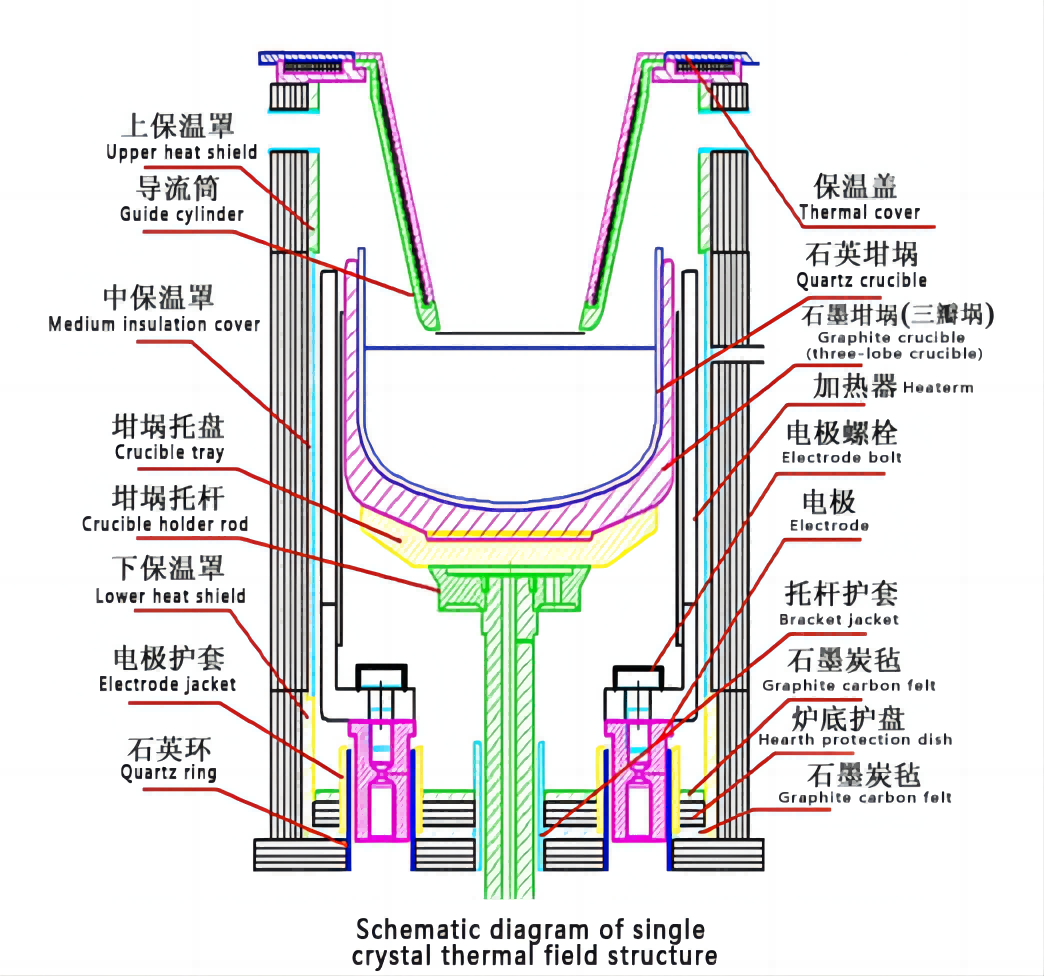Solar photovoltaic power generation has become the world's most promising new energy industry. Compared with polysilicon and amorphous silicon solar cells, monocrystalline silicon, as a photovoltaic power generation material, has a high photoelectric conversion efficiency and outstanding commercial advantages, and has become the mainstream of solar photovoltaic power generation. Czochralski (CZ) is one of the main methods to prepare monocrystalline silicon. The composition of Czochralski monocrystalline furnace includes furnace system, vacuum system, gas system, thermal field system and electrical control system. The thermal field system is one of the most important conditions for the growth of monocrystalline silicon, and the quality of monocrystalline silicon is directly affected by the temperature gradient distribution of the thermal field.
The thermal field components are mainly composed of carbon materials (graphite materials and carbon/carbon composite materials), which are divided into support parts, functional parts, heating elements, protective parts, thermal insulation materials, etc., according to their functions, as shown in Figure 1. As the size of monocrystalline silicon continues to increase, the size requirements for thermal field components are also increasing. Carbon/carbon composite materials become the first choice for thermal field materials for monocrystalline silicon due to its dimensional stability and excellent mechanical properties.
In the process of czochralcian monocrystalline silicon, the melting of silicon material will produce silicon vapor and molten silicon splash, resulting in the silicification erosion of carbon/carbon thermal field materials, and the mechanical properties and service life of carbon/carbon thermal field materials are seriously affected. Therefore, how to reduce the silicification erosion of carbon/carbon thermal field materials and improve their service life has become one of the common concerns of monocrystalline silicon manufacturers and carbon/carbon thermal field material manufacturers. Silicon carbide coating has become the first choice for surface coating protection of carbon/carbon thermal field materials due to its excellent thermal shock resistance and wear resistance.
In this paper, starting from carbon/carbon thermal field materials used in monocrystalline silicon production, the main preparation methods, advantages and disadvantages of silicon carbide coating are introduced. On this basis, the application and research progress of silicon carbide coating in carbon/carbon thermal field materials are reviewed according to the characteristics of carbon/carbon thermal field materials, and suggestions and development directions for surface coating protection of carbon/carbon thermal field materials are put forward.
1 Preparation technology of silicon carbide coating
1.1 Embedding method
The embedding method is often used to prepare the inner coating of silicon carbide in C/ C-sic composite material system. This method first uses mixed powder to wrap the carbon/carbon composite material, and then carries out heat treatment at a certain temperature. A series of complex physico-chemical reactions occur between the mixed powder and the surface of the sample to form the coating. Its advantage is that the process is simple, only a single process can prepare dense, crack-free matrix composite materials; Small size change from preform to final product; Suitable for any fiber reinforced structure; A certain composition gradient can be formed between the coating and the substrate, which is well combined with the substrate. However, there are also disadvantages, such as the chemical reaction at high temperature, which can damage the fiber, and the mechanical properties of carbon/carbon matrix decline. The uniformity of the coating is difficult to control, due to factors such as gravity, which makes the coating uneven.
1.2 Slurry coating method
Slurry coating method is to mix the coating material and binder into a mixture, evenly brush on the surface of the matrix, after drying in an inert atmosphere, the coated specimen is sintered at high temperature, and the required coating can be obtained. The advantages are that the process is simple and easy to operate, and the coating thickness is easy to control; The disadvantage is that there is poor bonding strength between the coating and the substrate, and the thermal shock resistance of the coating is poor, and the uniformity of the coating is low.
1.3 Chemical vapor reaction method
Chemical vapor reaction(CVR) method is a process method that evaporates solid silicon material into silicon vapor at a certain temperature, and then the silicon vapor diffuses into the inner and surface of the matrix, and reacts in situ with carbon in the matrix to produce silicon carbide. Its advantages include uniform atmosphere in the furnace, consistent reaction rate and deposition thickness of coated material everywhere; The process is simple and easy to operate, and the coating thickness can be controlled by changing the silicon vapor pressure, deposition time and other parameters. The disadvantage is that the sample is greatly affected by the position in the furnace, and the silicon vapor pressure in the furnace cannot reach the theoretical uniformity, resulting in uneven coating thickness.
1.4 Chemical vapor deposition method
Chemical vapor deposition (CVD) is a process in which hydrocarbons are used as gas source and high purity N2/Ar as carrier gas to introduce mixed gases into a chemical vapor reactor, and the hydrocarbons are decomposed, synthesized, diffused, adsorbed and resolved under certain temperature and pressure to form solid films on the surface of carbon/carbon composite materials. Its advantage is that the density and purity of the coating can be controlled; It is also suitable for work-piece with more complex shape; The crystal structure and surface morphology of the product can be controlled by adjusting the deposition parameters. The disadvantages are that the deposition rate is too low, the process is complex, the production cost is high, and there may be coating defects, such as cracks, mesh defects and surface defects.
In summary, the embedding method is limited to its technological characteristics, which is suitable for the development and production of laboratory and small-size materials; Coating method is not suitable for mass production because of its poor consistency. CVR method can meet the mass production of large size products, but it has higher requirements for equipment and technology. CVD method is an ideal method for preparing SIC coating, but its cost is higher than CVR method because of its difficulty in process control.
Post time: Feb-22-2024






